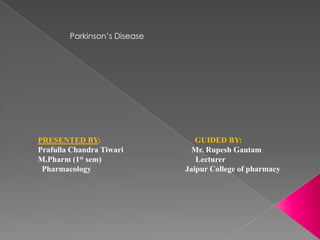
Parkinson's Disease Guide
- 1. Parkinson’s Disease PRESENTED BY: GUIDED BY: Prafulla Chandra Tiwari Mr. Rupesh Gautam M.Pharm (1st sem) Lecturer Pharmacology Jaipur College of pharmacy
- 2. PARKINSON'S DISEASE (PD) Clinical Overview. Parkinsonism is a clinical syndrome consisting of four cardinal features: bradykinesia (slowness and poverty of movement), muscular rigidity, resting tremor (which usually abates during voluntary movement), and an impairment of postural balance leading to disturbances of gait and falling .
- 3. Etiology The most common cause of parkinsonism is idiopathic PD, first described by James Parkinson in 1817 as paralysis agitans, or the "shaking palsy." The pathological hallmark of PD is a loss of the pigmented, dopaminergic neurons of the substantia nigra pars compacta, with the appearance of intracellular inclusions known as Lewy bodies.
- 4. Progressive loss of dopamine- containing neurons is a feature of normal aging; however, most people do not lose the 70% to 80% of dopaminergic neurons required to cause symptomatic PD.
- 5. Pathophysiology. The primary deficit in PD is a loss of the neurons in the substantia nigra pars compacta that provide dopaminergic innervation to the striatum (caudate and putamen).
- 6. The current understanding of the pathophysiology of PD can be traced to neurochemical investigations that demonstrated a reduction in the striatal dopamine content in excess of 80%.
- 7. The current understanding of the pathophysiology of PD can be traced to neurochemical investigations that demonstrated a reduction in the striatal dopamine content in excess of 80%.
- 8. This paralleled the loss of neurons from the substantia nigra, suggesting that replacement of dopamine could restore function. These fundamental observations led to an extensive investigative effort to understand the metabolism and actions of dopamine and to learn how a deficit in dopamine gives rise to the clinical features of PD.
- 9. Dopamine Synthesis and Metabolism. Dopamine, a catecholamine, is synthesized in the terminals of dopaminergic neurons from tyrosine and stored, released, and metabolized
- 11. Dopamine Receptors. The actions of dopamine in the brain are mediated by a family of dopamine-receptor proteins . Two types of dopamine receptors were identified in the mammalian brain using pharmacological techniques: D1 receptors, which stimulate the synthesis of the intracellular second messenger cyclic AMP, and D2 receptors, which inhibit cyclic AMP synthesis as well as suppress Ca2+ currents and activate receptor-operated K+ currents.
- 12. The five dopamine receptors can be divided into two groups on the basis of their pharmacological and structural properties . The D1 and D5 proteins have a long intracellular carboxy- terminal tail and are members of the class defined pharmacologically as D1; they stimulate the formation of cyclic AMP and phosphatidyl inositol hydrolysis.
- 13. The D2, D3, and D4 receptors share a large third intracellular loop and are of the D2 class. They decrease cyclic AMP formation and modulate K+ and Ca2+ currents. Each of the five dopamine receptor proteins has a distinct anatomical pattern of expression in the brain.
- 14. The D1 and D2 proteins are abundant in the striatum and are the most important receptor sites with regard to the causes and treatment of PD. The D4 and D5 proteins are largely extrastriatal, whereas D3 expression is low in the caudate and putamen but more abundant in the nucleus accumbens and olfactory tubercle.
- 15. Neural Mechanism of Parkinsonism. Considerable effort has been devoted to understanding how the loss of dopaminergic input to the neurons of the neostriatum gives rise to the clinical features of PD .
- 16. The basal ganglia can be viewed as a modulatory side loop that regulates the flow of information from the cerebral cortex to the motor neurons of the spinal cord.
- 17. The basal ganglia can be viewed as a modulatory side loop that regulates the flow of information from the cerebral cortex to the motor neurons of the spinal cord
- 19. The neostriatum is the principal input structure of the basal ganglia and receives excitatory glutamatergic input from many areas of the cortex. Most neurons within the striatum are projection neurons that innervate other basal ganglia structures..
- 20. A small but important subgroup of striatal neurons consists of interneurons that connect neurons within the striatum but do not project beyond its borders. Acetylcholine and neuropeptides are used as transmitters by these striatal interneurons
- 21. The outflow of the striatum proceeds along two distinct routes, termed the direct and indirect pathways. The direct pathway is formed by neurons in the striatum that project directly to the output stages of the basal ganglia, the substantia nigra pars reticulata (SNpr) and the globus pallidus interna (GPi); these, in turn, relay to the ventroanterior and ventrolateral thalamus, which provides excitatory input to the cortex.
- 22. The indirect pathway is composed of striatal neurons that project to the globus pallidus externa (GPe). This structure, in turn, innervates the subthalamic nucleus (STN), which provides outflow to the SNpr and GPi output stage.
- 23. The dopaminergic neurons of the substantia nigra pars compacta (SNpc) innervate all parts of the striatum; however, the target striatal neurons express distinct types of dopamine receptors
- 24. The striatal neurons giving rise to the direct pathway express primarily the excitatory D1 dopamine receptor protein, whereas the striatal neurons forming the indirect pathway express primarily the inhibitory D2 type.
- 25. Thus dopamine released in the striatum tends to increase the activity of the direct pathway and reduce the activity of the indirect pathway, whereas the depletion that occurs in PD has the opposite effect.
- 26. TREATMENT OF PARKINSON'S DISEASE
